How To Fix A Leaky Outdoor Faucet In Winter
 Faucets, Sill-cocks, Hose Bibbs & hose hook-up Repair
Faucets, Sill-cocks, Hose Bibbs & hose hook-up Repair
Outdoor faucet types, installation, repairs
- POST a QUESTION or COMMENT about outdoor wall faucets, sillcocks, hose bibbs, and freezeproof or frostproof faucets or faucet troubleshooting
InspectAPedia tolerates no conflicts of interest. We have no relationship with advertisers, products, or services discussed at this website.
Outdoor faucets, hose bibbs, & outdoor hose connections:
This article describes outdoor faucets, hose bibbs, sillcocks, or hose hookups, how they work, where they should be installed, freeze-proofing hose hookups, and troubleshooting or repairing stuck, broken, or dripping outdoor faucets.
We describe the component parts of outdoor faucets, how water flows through the faucet, and where drips or leaks occur. Leaky outdoor faucet repair instructions address each of these faucet leak locations & types and suggest a repair sequence from easiest that may work to more challenging faucet repairs that may be necessary.
Our photo at page top shows water gushing out of the building wall just above the foundation. The owner/occupant had forgotten to turn off water to the outside hose hook-up, leaving that line full of water. The water line just inside the foundation froze and burst.
We also provide an ARTICLE INDEX for this topic, or you can try the page top or bottom SEARCH BOX as a quick way to find information you need.
Outdoor Faucets & How to Fix Leaks
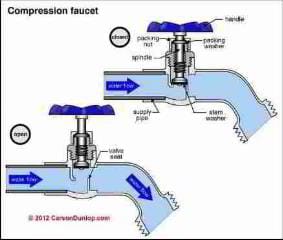 This article series describes how to repair leaks at outdoor faucets, or spigots or as some fancy inspectors call them, "hose bibbs" or "sillcocks".
This article series describes how to repair leaks at outdoor faucets, or spigots or as some fancy inspectors call them, "hose bibbs" or "sillcocks".
We describe different types of spigots including newer, code-required anti-siphon sillcocks, then we describe step by step repairs for each type of leak that occurs at these spigots:
- FAUCET LEAK, VALVE STEM REPAIR - Traditional compression type faucets that leak around the faucet valve shaft - repairable either by simple tightening of the packing nut or by replacing the valve stem packing. This repair is discussed below on this page.
- FAUCET LEAK, WASHER REPLACEMENT - Traditional faucets that leak by dripping from the spout, repaired by simply replacing a faucet washer.
- FAUCET LEAK, VALVE SEAT REPAIR - Traditional faucets that leak because the valve seat is corroded or nicked - also repairable using a simple tool.
- SILLCOCK INSTALLATION & REPAIR - leaks at frost-proof outdoor spigots encompassing an anti-siphon valve including leaks from the vacuum breaker cap
Below we continue by describing each of the first three types of leaks at conventional or "Old-Fashioned" outdoor spigots. We explain the cause of and repair for each of those leaks.
But first let's be sure we know what kind of outdoor spigot is installed, since the parts and repair procedures are different depending on what kind of faucet you've got.
What Kind of Faucet Have I Got?
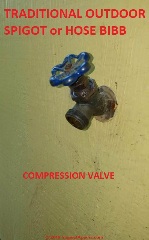
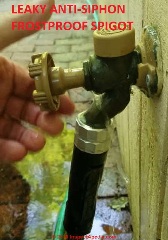
If your outdoor faucet looks like our first photo at above, and if needs repair, it is NOT a frost-proof anti-siphon valve, it's a traditional compression valve faucet or spigot.
Our second photo above is a typical frost-free anti-siphon faucet, or "Woodford" valve. Repairing that faucet is discussed separately
at FAUCET, SILLCOCK ANTI SIPHON LEAK REPAIR
How to Fix a Leaky Outdoor Faucet - leaks around the valve stem
 Traditional outdoor hose bibbs used in non-freezing climates - Compression Faucets
Traditional outdoor hose bibbs used in non-freezing climates - Compression Faucets
Traditional compression faucets (shown at left) allow water to flow from the building supply piping out through the faucet mouth by opening (turning) the valve handle counter-clockwise (to the left when looking at the top or face of the handle).
[Click to enlarge any image]
As you can see in our sketch at left (courtesy of Carson Dunlop Associates a Toronto home inspection, report writing tool & education firm), opening the faucet allows water to flow from the pipe up through a passage cast into the body of the faucet and out the faucet mouth.
When this type of faucet is closed, the stem washer presses against the faces of the valve seat to stop water flow.
This faucet, when mounted on the wall of a building in freezing climates, is not protected from frost damage and can freeze, break, and subsequently leak when freezing conditions warm up.
If you live in a freezing-climate and if your outdoor faucet is the older type that is not frost-proof (photo at left), you should be able to turn off water to that faucet and open a small screw fitting on the faucet body side to assist in draining that device when draining the building piping.
For the hose bibb shown at left, we found a water shut-off inside the building close to this device.
This hose bibb was also leaking - a slow drip. By installing the duplex hose splitter with two small black valve controls we could use that device to stop the drip - a temporary repair. The right repair for a drippy faucet, as we will show below, is to replace the stem washer and if necessary, grind smooth the valve stem seat.
Watch out: notice that hose splitter attached to the sillcock at left? If those little black valves are left in the "closed" position in winter the faucet won't drain even when shut-off inside, and it may freeze and break.
Even in a building where heat and water are being left on for the winter we make sure to find and use (or install if needed) the valve to turn off water to each outdoor faucet.
Then we open the faucet to let it drain, leaving it open (and making sure it's not dripping from an indoor shutoff valve that is not working well).
Watch out: Never leave a garden hose attached to your outdoor faucet in winter as water in the hose may add to the risk that the faucet will be freeze damaged.
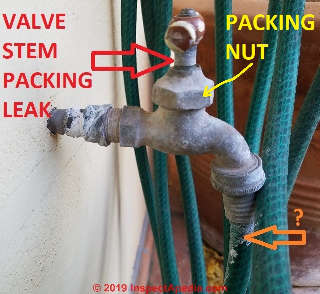 How to Repair a faucet that leaks around the valve stem when the faucet is turned on
How to Repair a faucet that leaks around the valve stem when the faucet is turned on
Leaks at an outdoor hose bibb or frost-proof faucet range from a drip to water gushing out of the faucet or out of the anti-siphon vent such as the leaky faucet shown in our photo at the top of this page. The repair of a dripping hose bibb of this type depends on where the leak is occurring.
In our photo of a hose bibb or faucet in San Miguel de Allende the smaller orange arrow (lower right) shows white deposits on the garden hose below the faucet mouth: those may be due to leaks at the valve stem or leaks at the connection of the garden hose to the faucet mouth. But the corrosion on the valve stem tells the story.
The larger red arrow points to white mineral deposits around the valve stem - telling us that whenever it was turned on this spigot has leaked for some time, probably years.
How to Fix a Leak at the Faucet Valve Stem
This common leak can usually be fixed by gently tightening the large packing nut (yellow arrow in our photo - also see Carson Dunlop's sketch below).
Tightening the packing nut (yellow arrow) by turning it clockwise may further compress the packing washer to cause it to squeeze more tightly around the valve stem and stopping the leak.
Watch out: do not so over-tighten the packing nut on the faucet that you cause it to crack or break, or it's new faucet time. Try just turning it 1/4 turn, then open the faucet again to see if the leak has been repaired. Tighten in small increments.
Don't tighten more than necessary or you'll find that the faucet handle becomes very difficult to turn.
If tightening the faucet packing nut does not stop the leak around the valve stem you can often repair this component easily.
How to Replace a Faucet Valve Stem Packing

- Turn off the main water shutoff that feeds this water pipe
- Open the faucet to drain off water and pressure.
- Remove the faucet handle - this means loosening the screw in the center of the handle that holds the handle to the faucet stem or spindle.
- Gently wiggle the faucet handle side to side while pulling it away from the faucet stem to remove it.
- Unscrew the packing nut - this should expose the packing washer.
- Pull off the packing washer and install a new one of the same size and type.
Tip: old plumbers used to carry a graphite-impregnated string that could be coiled around the valve stem and tightened in place in lieu of the factory-provided packing washer. As the domed packing nut is tightened the graphite string (still available from plumbing suppliers) squashes to seal around the valve stem.
Stem packing is still sold both in graphite string form and in teflon string form by Larsen and other suppliers.
In a pinch, when I could not find a matching graphite or nylon dome-shaped valve stem packing washer I've sued a nylon bonnet packing (used on Crane tub faucets) or a thick rubber shower stem valve packing washer that squashed enough to fit other brand valve stems.
Bring your valve stem to your hardware store and find a stem packing washer that is snug around the stem diameter.
- Replace the packing nut and faucet handle and close the faucet.
Tip: tighten the packing nut snugly - until you feel resistance when you turn the faucet handle, but don't make it so tight that you crack the nut or so tight that turning the handle is difficult.
- Turn the water supply back on and check for leaks.
- Tighten the packing nut further if water is leaking around the stem.
Reader Question: Our rarely-used outdoor faucet seems to be clogged internally, maybe with mud. What does the faucet look inside like & how can I clean it out?
 First Thank you for all your wonderful help a couple of years ago with my well and septic tank issues. All fixed now. Do you have any diagrams of what the INSIDE of an outdoor faucet (attached to the house) looks like.
First Thank you for all your wonderful help a couple of years ago with my well and septic tank issues. All fixed now. Do you have any diagrams of what the INSIDE of an outdoor faucet (attached to the house) looks like.
I have one that is essentially never used except at the water supply for my swamp cooler in the summer. I am sure it is plugged with mud from all the times the well has been pulled out of the ground over the years and it now seems to be bad enough to be affecting the flow to the cooler.
If I knew what the inside looked like I could at least try to unclog it a little at a time. I am told that because it is almost as old as the house (39yr) that it could break if I tried to remove it to replace it.
I have tried pipe cleaners, wire, water pressure (syringe with Christmas tree adapter), all with no luck. If I just knew what it looked like inside I like to think it would help. Thanks, - S.F.
Reply:
Thanks for the nice note. We are always very happy when our information proves useful, and thus much welcome questions & content suggestions such as your own. Because you live in an area where swamp coolers are used, I infer that you're not in a freezing-climate and that your hose faucet is a simple one such as we show above.
Provided you are talking really about an outdoor faucet or hose bibb, (not a water flow control valve installed in a section of water piping) the illustration provided earlier on this page and reproduced at above-left shows what a warm-climate standard hose faucet looks like.
You can see from the cross sectional drawing that the bottom of the feed-pipe and faucet body could indeed accumulate mud and crud, leading to a clog that prevents water flow even when the faucet is "opened".
A simple fix for a debris-clogged faucet that usually works, though it sprays water all over the place (so is only suitable for outdoor repairs) is as follows:
- Loosen the faucet packing nut to expose the (usually but not always present) smaller nut below the packing nut that secures the stem assembly to the faucet body. You may have to remove the faucet handle to be able to un-screw the packing nut and smaller stem nut completely.
- Turn the faucet towards its "open" position (you may have to put the faucet handle back on to do this) which will now unscrew the faucet stem assembly from the valve body.
This will give a view into the faucet interior body. If you see mud and crud therein, stand back, and turn on the building water supply to this faucet.
The water should push the mud/crud right out of the faucet assembly and should flush it clean. If not you may need to pick at the internals of the faucet body to loosen hard-packed mud/crud.
Watch out: don't scratch up the valve seat face with a digging tool or the faucet may drip on reassembly.
Before reassembling the faucet, we recommend
- Installing a new faucet stem washer and screw
- A dab of non-hardening teflon paste on the stem washer screw and on all other threaded parts.
How to Fix a Dripping Hose Faucet or Stop Valve: Replace the Valve Stem Washer
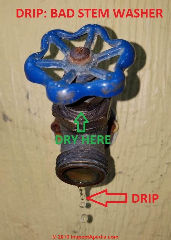
If the faucet or hose bibb drips when the valve is closed tightly, and if there is no leakage around the valve stem, then the problem is probably the valve stem washer - you'll want to replace just the washer itself.
Details of how to make this repair have moved to
FAUCET LEAK, WASHER REPLACEMENT
Repair a Leaky Frost-proof Outdoor Faucet SillCock or Hose Bibb
 This topic has moved to a separate page at SILLCOCK INSTALLATION & REPAIR
This topic has moved to a separate page at SILLCOCK INSTALLATION & REPAIR
As our illustration below explains, the long shaft (green) of this frost-proof faucet permits the actual stem washer and valve seat to be located on the warm side of the building exterior wall.
A hose bibb faucet that includes a vacuum breaker is designed to permit water to drain out of the faucet when the faucet is closed.
The attached atmospheric vent (allowing air into the faucet) combines with a check valve to prevent back-flow of unsanitary water from a garden hose backwards into the building water supply piping.
The check-valve shown here prevents back-flow into the building.
How to Repair a Leaky Faucet Valve Seat
This discussion has moved to FAUCET LEAK, VALVE SEAT REPAIR
How to Redirect an Outdoor Spigot that is Too Low or Too Close to an Obstruction
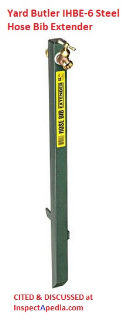 Mark:
Mark:
How to raise a hose spigot or faucet or "hose bibb" that is too close to the ground
Take a look at my answer to Thom, below, where I illustrate hose bibb attachments that make a 90 or 45 degree bend. You can certainly connect a couple of these to point to the left, then up, then out to construct a hose connection point that is higher on the building wall.
For example, where we needed to attach a sprinkler system timer to a building in New York I used a short section of flexible hose that connected the hose bibb to a point higher on the building wall from which we had room to connect the sprinkler timer assembly.
For a semi-permanent hose bibb extender that gets the hose connection higher above ground level, use a short section of garden hose to connect the existing hose bibb to the extender I illustrate just below, then affix that extender to your building wall a bit off to one side of the existing hose bibb.
The vertical hose bibb extender (Yard Butler IHBE-6 Steel Hose Bib Extender) I show is sold by garden supply outlets for about $30. U.S.
You leave the lower hose spigot ON and turn water on and off at the extender.
Watch out: I would not leave this arrangement on at the original spigot (hose bibb) if going away from the building for any extended period. With water left "on" at the source hose bibb, if the extension hose between the source bibb and the extension bibb were to burst, water would be left running indefinitely, wasting water and possibly causing local water damage.
In a still more complex and fancier design, if your water source is a local water pump, there are some pumps such as our The Grundfos SCALA2 pressure pump described
at WATER PUMP PRESSURE SENSITIVE that are so smart that the pump can detect when water is running in a manner that there is a leak somewhere - that pump will then shut down automagically.
I got a spigot like ground level. Is there things i can do to raise it higher. Besides running a new line.
 Anon
Anon
Thank you for an interesting question.
Certainly, there are splitting devices basically a y-shaped add-on that will allow you to connect to hoses to hose bib. In fact, there are connectors that will connect many more hoses than that.
However, there are a couple of reasons why I wouldn't consider feeding a water heater. From a hose connection.
First I don't ever want to run permanent Plumbing using a flexible garden hose. Leaving the hose under pressure at all times as would be necessary in this case risks a burst hose and flood. , worse if it happens when you're away from home.
If you live in a freezing climate, you would not want to feed your water heater from a split off of your hose bib because of the risk that that line could freeze in winter.
Below I show a multi-hose splitter that offers more possibilities. We used this splitter to supply multiple automatic lawn sprinklers.
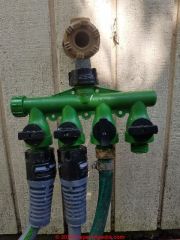
Can I run a splitter of some sort fro my exterior spigot line into my garage? I need to run a line to an on-demand single- point water heater.
Thom:
You can buy a hose bibb or spigot attachment that gives you a 90 degree elbow, or a 45 degree elbow that can be installed with the hose attachment point facing out away from the building.
Below is an example: Camco 90 Degree Hose Elbow- Eliminates Stress Strain On RV Water Intake Hose Fittings, Solid Brass (22505)

I have a spigot that is facing a post and is not useful. How can i reverse the spigot so that will of use to me?
My spigot is facing a post and there is no room to attach a hose. How can flip the spigot to face away from the post so a hose can be attached to the spigot for use?
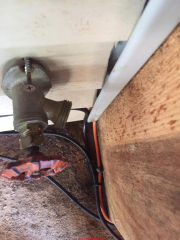
Reader Q&A - also see the FAQs series linked-to below
@Jiffy@startmail.com,
Bottom line: I doubt that your spray foam treatment is itself going to cause harm to the plumbing system nor to affect freeze risk except that by blocking cold air drafts through a wall you may reduce freezing of interior water pipes.
Details:
Your question of the relationship between freeze-risk and adding pipe insulation is interesting and tricky. What follows is OPINION not science as we haven't a shred of specific information about your exact building nor its weather exposures.
In general:
Adding pipe
insulation preserves heat or warmth already present inside of the piping as outdoor or surrounding temperatures drop and thus slows the rate at which the pipe is likely to freeze.
In a climate where we expect a brief temperature drop followed by warming the insulation may be all that is needed.
If the climate is one in which the warming interval is brief and the cold interval is longer than the insulation, unfortunately, prevents regain of sufficient heat in the pipe head over a series of such cycles the pipe may freeze.
In a climate of prolonged low temperatures such as people in Texas experienced recently over a period of several days, insulation on piping may not be enough to prevent freezing and you may need either to provide a heat source or to have installed a collection of plumbing details and features that prevent freezing. For an outdoor
faucet or gate valve as you described, there are of course frost proof faucets that turn off the actual water supply deeper inside of the building. That will prevent freezing at the faucet or hose bibb (your "gate valve" ) itself.
Given the global warming and shifts in the polar air mass may mean that Texas is going to be exposed to these freaking cold snaps again in the future, certainly new construction needs to provide for adequate protection of pipes from freezing. In buildings that will not be occupied or not have heat kept on it is still possible to prevent frozen pipe damages by designing the water supply piping to drain back empty where the building is shut down.
For our readers in Southern U.S. who are not used to having frozen pipe problems, I recommend these articles:
FAUCET, SILLCOCK ANTI SIPHON LEAK REPAIR https://inspectapedia.com/plumbing/Woodford-Sillcock-Anti-Siphon-Valve-Repair.php discusses installing or repairing frost-proof sillcocks (hose bibbs or spigots)
FREEZE-PROOF PIPES https://inspectapedia.com/plumbing/Pipe_Freeze_Protection.php discusses how best to protect pipes from freezing
WINTERIZE - HEAT ON PROCEDURE - https://inspectapedia.com/plumbing/Winterize_Heat_On.php how to protect buildings from freeze damage when heat will be left on
WINTERIZE - HEAT OFF PROCEDURE https://inspectapedia.com/plumbing/Winterize_Heat_Off.php how to protect buildings from freeze damage if heat is to be left off
WINTERIZING an RV or MOBILE HOME https://inspectapedia.com/Manufactured_Homes/Mobile_Home_Labels.php#Winterize freeze protections for mobile homes
FROZEN PIPE THAW-OUT https://inspectapedia.com/plumbing/De_Winterize_Buildings.php#Freeze5
and for people who may already be frozen-up (or their pipes are frozen anway)
DE-WINTERIZE a BUILDING https://inspectapedia.com/plumbing/De_Winterize_Buildings.php
includes tips on how to avoid terrible water and mold damage when thawing out a building where pipes may have frozen and burst
I changed my outdoor gate-valve faucets to a "T" with two ball valves. Then we got hit by the Texas deep freeze. I mitered some pipe foam around the "T" and sprayed foam insulation around and crevices. (Those foam boxes won't fit around my valve manifold.) Have I created a problem prone to freezes? Thanks.
jiffy@startmail.com
I would remove the adapter-it simply unscrews from the faucet.
Take the part to your hardware ir garden supply store to find a deep adapter.
Thank you so much for the quick and detailed reply, this all makes sense to me now. However, I have several hoses, and none of the female connectors are long enough to reach the perforated fitting, so is there some sort of connector or adapter available that will prevent leaking?
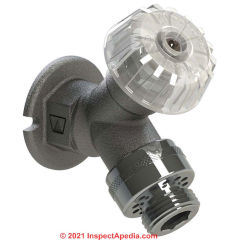 Pine
Pine
Thank you for the interesting question and outdoor faucet photo.
In your photo that's a Woodford Model 24 anti-siphon hose bibb or outdoor faucet.
That perforated fitting is a vacuum breaker - that's the anti-siphon feature. This hose bibb is for use only in non-freezing climates.
Those perforations are there to allow air into the faucet body when needed to prevent siphoning by the hose.
The connector should not be leaking but might if the female hose connector your are attaching is not deep enough or does not have a washer of sufficient diameter and thickness.
You can read the product specs at
https://inspectapedia.com/plumbing/Anti-Siphon-Hose-Connector-Woodford-Model-24.pdf
and if you're having trouble with your anti-siphon faucet you can contact the company for help:
WOODFORD MANUFACTURING COMPANY
2121 WAYNOKA ROAD COLORADO SPRINGS, CO 80915 USA
Phone (800) 621-6032 Fax (800) 765-4115
Website: www.woodfordmfg.com
Email: sales@woodfordmfg.com
I have a exterior faucet similar to the image attached, [photo above] and I have no idea what it is.
In particular, the purpose of the holes surrounding the threaded part.
Obviously, when I attach a regular hose, water comes pouring out from around the hose from these holes. Somis there a special hose attachment I should know about? Thanks in advance,l
Depending on the brand, model, and age of your faucet it may be possible to replace the stem assembly. On older homes I have generally not had good luck with that approach and I've instead replaced the entire faucet.
My outdoor faucet leaks from the handle when it's on. I can loosen the packing nut but I can not seem to budge the nut on the handle in order to get to the packing washer (I also tried to loosen the stem screw with no luck and stripped that screw). Can I replace the entire stem assembly or will it be too difficult to match with my existing spigot and I need to replace the whole faucet?
Mark:
Please find your question and my detailed reply now near the end of the article above on this page.
Let me know what questions remain.
Thanks for asking a helpful question.
I got a spigot like ground level. Is there things i can do to raise it higher. Besides running a new line.
I'm not sure, Anon, since a "sill cock" or "hose bibb" as discussed on this page are used as an outdoor spigot or garden hose connection and are normally connected to the building cold water supply piping, while the drain valve on an evaporative cooler is not and should not be used for normal outdoor watering.
That valve is there to permit draining the evaporative cooler as part of cleaning and maintenance.
The exact reason that ANY water shutoff valve is leaking can vary but the most common causes are
- a lost or damaged stop washer inside the valve if it's a stop valve
- a leaky valve stem washer that can sometimes be fixed by tightening the bell nut or cap nut on the stop valve or sillcock
- corrosion of valve internal parts
- (rarely) other mechanical damage to the valve
- (not likely to pertain to your stop valve but likely on anti-siphon outdoor faucets) a damaged or leaky anti-siphon valve on the sillcock
Perhaps if you attach a photo of your evaporative cooler and in a second comment a photo close-up of your valve I can see the valve type and can offer more specific advice.
Why does my evaporative cooler sill cock not stop the water when handle is turned to off?
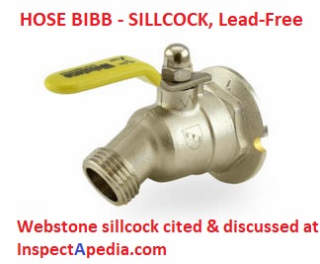 No, Roy, there are some models of sillcocks or hose bibs that use stainless steel or other materials and that are specifically promoted as "lead free".
No, Roy, there are some models of sillcocks or hose bibs that use stainless steel or other materials and that are specifically promoted as "lead free".
Also not all brass must contain lead.
Raven makes stainless steel sillcocks
Other brands advertising lead free sillcocks include
Matco-Norca
Proline
Watts
Webstone
and surely there other manufacturers, varying by country.
Shown below is a nickel-plated brass lead free sillcock from Webstone.
Are all sill cocks/hose bibs contaminated with lead?
...
Continue reading at FAUCET LEAK, WASHER REPLACEMENT or select a topic from the closely-related articles below, or see the complete ARTICLE INDEX.
Or see FAUCETS, OUTDOOR HOSE BIBB REPAIR FAQs - questions & answers posted originally on this page.
Or see these
Faucet Repair Articles
- FAUCETS & CONTROLS, KITCHEN & BATH
- FAUCETS, OUTDOOR HOSE BIBBS
- FAUCET LEAK, VALVE SEAT REPAIR
- FAUCET LEAK, VALVE STEM REPAIR
- FAUCET LEAK, WASHER REPLACEMENT
- FAUCET, SILLCOCK ANTI SIPHON LEAK REPAIR
- FREEZE-PROOF PIPES
- PLUMBING CONTROLS & VALVES - photos and descriptions of all types of plumbing valves.
Suggested citation for this web page
FAUCETS, OUTDOOR HOSE BIBBS at InspectApedia.com - online encyclopedia of building & environmental inspection, testing, diagnosis, repair, & problem prevention advice.
Or see this
INDEX to RELATED ARTICLES: ARTICLE INDEX to PLUMBING VALVES
Or use the SEARCH BOX found below to Ask a Question or Search InspectApedia
How To Fix A Leaky Outdoor Faucet In Winter
Source: https://inspectapedia.com/plumbing/Faucets_Outdoor.php
Posted by: moorewharyince.blogspot.com

0 Response to "How To Fix A Leaky Outdoor Faucet In Winter"
Post a Comment